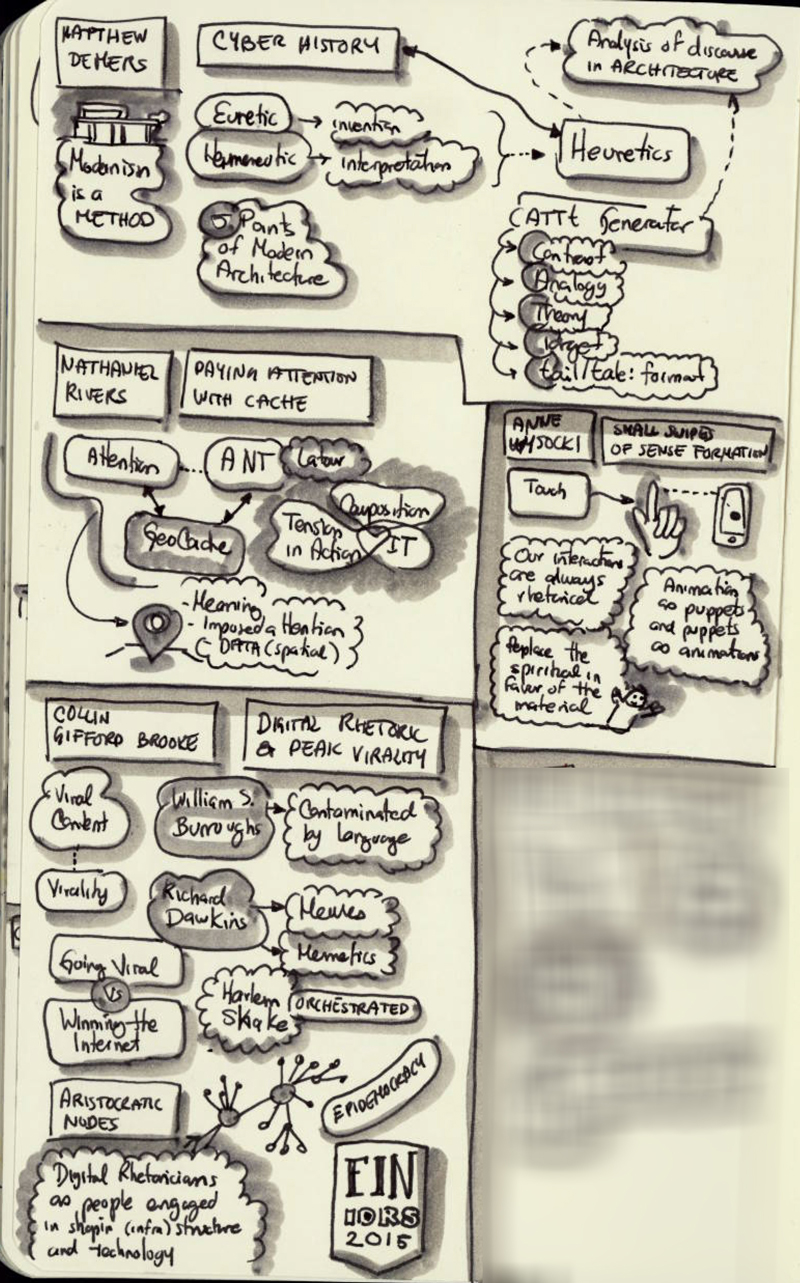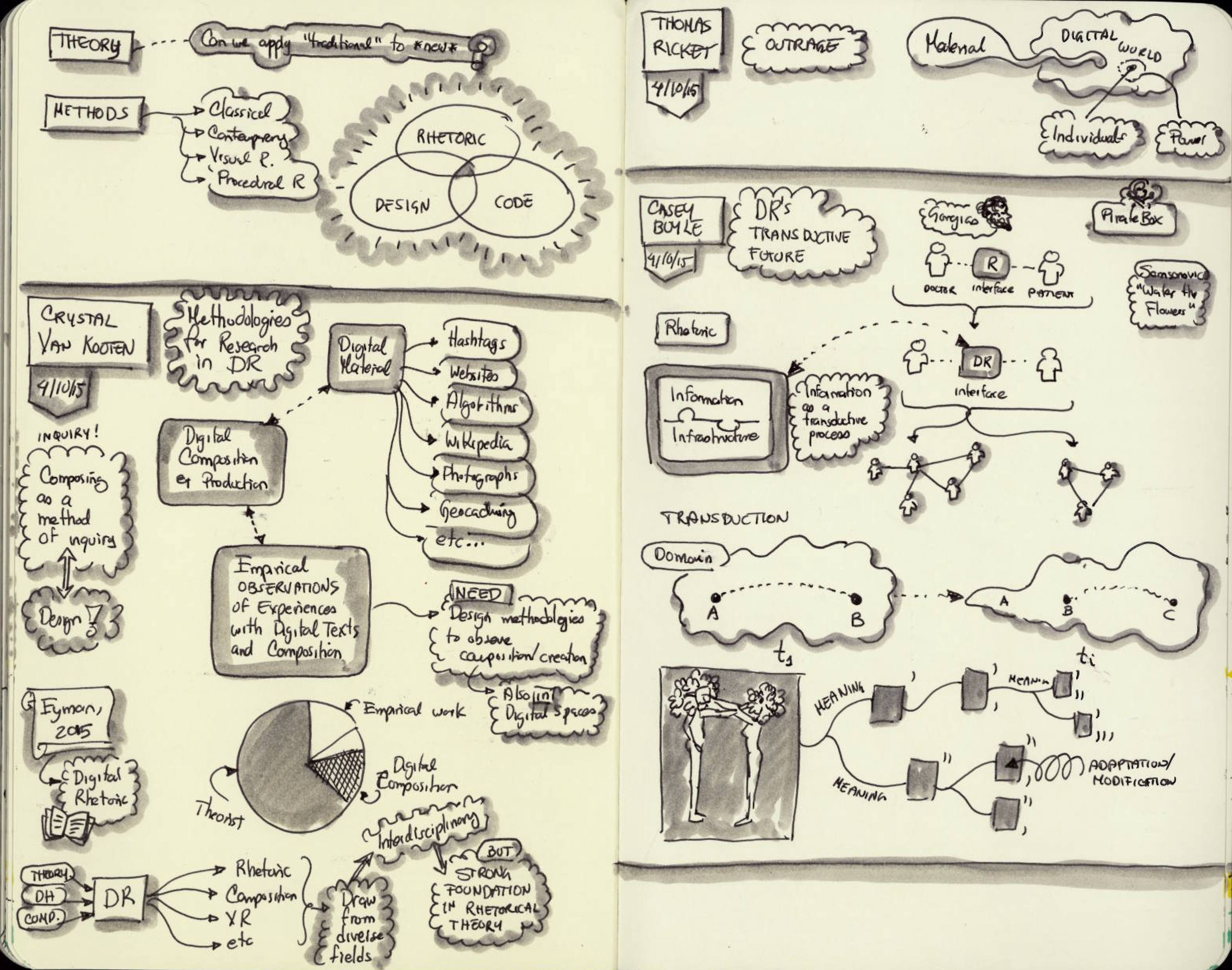My research tries to connect the design of user interfaces, information design and rhetoric. For this reason, the Indiana Digital Rhetoric Symposium represented a good opportunity for me to learn more about the meaning and implications of technology, not only in the way that we communicate, but also in how we shape our “symbolic” world. During the symposium, I discovered an interesting perspective about data and interactions with computer systems, complementary to the discourse in Informatics. In this post, the sketchnotes that I took during the symposium are presented. In the middle of them, there are also notes on the talk “Big Data or Right Data?” which occurred concurrently with the symposium. It was a nice coincidence. Through my notes, I tried to capture some of the key ideas from the talks with visual anchors that can help me recall and reflect about the ideas presented during the event.
Unfortunately, I couldn’t take notes from Elizabeth Losh’s interesting talk, “Sensing Elsewhere: Alterity in Digital Rhetorics.” But I was ready and excited about doing some sketchnotes the next morning. Below, I show the first page. It corresponds to the talk “Defining Digital Rhetoric: Theory, Method, Practice, Pedagogy” by Doug Eyman.

In the image below, there is one more note from Eyman’s talk (left page, top), followed by the notes from Crystal VanKooten’s talk, “Methodologies for Research in Digital Rhetoric: A Survey of an Emerging Field” (left page, bottom). As Crystal pointed out, I also consider that paying attention to the digital material is important. As a HCI/UX design researcher, I am interested in composing as a method of inquiry since I relate composition to design. Crystal’s talk helped me to glimpse how Digital Rhetoric tries to frame composition in the digital realm, but demands a strong rhetorical foundation. The talk by Thomas Rickert “Go Ahead, Bite the Big Apple, Don’t Mind the Morals: Rhetoric, Digitality, Moralism” was related to material in the digital world (right page, top). Then, Casey Boyle talked about transduction in the talk “Notes from Digital Rhetoric’s Transductive Future.” From this talk, I found it very interesting to see meaning as something that evolves. I think that transduction could be use to describe the so-called user experience (when interacting with computer systems) in terms of evolving meaning (right page, sketchnote at bottom). It seems to be a good research idea to explore.

The session hadn’t finished yet, and more interesting ideas kept being presented (left page). In the talk “Making Wayves: Transduction, Rhetorical Style, and Writing-as-Line,” David Rieder pointed out that digital rhetoric is sometimes a result of a harmony between the digital and the analog, which requires the inclusion of other disciplines, other ways of thinking. To me, David’s talk fits properly with HCI and UX. As occurred with Casey’s talk, too, there seems to be an interesting overlapping between the discourses of digital rhetoric and HCI. From these talks, a question came to my mind: what does it mean to describe UX in terms of the branches of oratory/rhetoric? In my PhD studies, I’m trying to push the idea of systems as arguments, and listening to David and Casey was inspirational. From that day, I also have some notes from the talks by Byron Hawk, Kevin Brock, Annette Vee, and James Brown (page left, middle and bottom).
In the same day, the School of Informatics and Computing had invited Ricardo Baeza-Yates (VP Yahoo Labs) to give a talk. I think it was a nice coincidence! The downside is that I missed the IDRS talks about rhetoric and algorithms. Ricardos’s talk was called “Big Data or Right Data” (right page). To some extent, attending this talk is about discovering “the other side of the coin.” This talk was oriented to informaticians, computer scientists, and information scientists, which makes it look unrelated to digital rhetoric. Nevertheless, Ricardo’s argument relates to composition and meaning. Through this talk, Ricardo emphasized that collecting large amounts of data from users is not always the best approach to information retrieval. He pointed out that finding computational solutions that deal with large data sets implies the need to consider the volume, variety, veracity and value of the data (right page, middle). I find interesting how colleagues in informatics implicitly consider the implications for the user through an understanding of the computational implementation (i.e., the algorithm or method), whereas in digital rhetoric, the user (the person using the digital material that results from such implementation) has a centric position.

Below, are the first notes of the last day, which started with Kristin Arola’s talk, “Ayaangwaamizin: Digital Texts, Cultural Rhetoric, and an Ethic of Care.” To some extent, I glimpsed again a relation with my colleagues from the School of Informatics and Computing, particularly with the people researching Complex Systems, the type of system that is neither completely stochastic or completely deterministic (e.g., social media). People in complex systems aim to observe and understand patterns that emerge in these types of systems (e.g., information propagation in Twitter), while digital rhetoricians seem to focus on the role of the individual (person or code) in these types of systems (e.g., an assiduous Twitter user). When Angela Aguayo talked about digital rhetoric and agency in “Digital Rhetoric and the Rural Civil Rights Project” (left page, right top corner), another question came to my mind: how does the UX or HCI design support or foster agency? In the symposium it was illustrated how social media (especially, Twitter) relates to rhetorical agency, but I still wonder how the design process and the designer’s decisions regarding the system and user interface could foster or constrain the user’s rhetorical agency. I think that paying attention to what the user does with technology is important, but also to consider the role of the designer and the designer’s intent as part of the discussion in digital rhetoric. With this thought in mind, I listened to the talks of the last day, including “Protest Photography in a “Post-Occupy World”: Keywords for a Digital Visual Rhetoric of Public Discourse” by Emily Cram (left page, middle), “Creating with the “Universe of the Undiscussed”: Hashtags, Doxa, and Choric Invention” by Caddie Alford (left page, bottom), “Ethos, Hexis, and the Case for Persuasive Technologies” by Steven Holmes (left page, bottom right corner and right page top).
The last talk of the morning sessions was “The Lessons of Hill’s Manual of Social and Business Forms for Rhetorical Delivery” by Kathleen Blake Yancey (right page, middle). As an amateur calligrapher and typography lover, I really enjoyed this talk. However, her point about considering layout, aesthetic, delivery, and circulation as a whole was really inspiring. As a designer, I aligned with her idea that these elements combine to create a unique user experience. It is not only about the content. The experience is the combination of these factors. I couldn’t avoid asking myself: how can Kathleen’s ideas be taught to UX/HCI designers? Then, Jon Wargo talked about “Elastic Literacies, Queer Sponsorscapes, and Mobile Media: Lessons from Youth on Digital Rhetoric” (right page, middle), Sarah Arroyo talked about “Growing Up with Electracy” (Right page almost at the bottom), and Jeff Rice emphasized the “I am” in the talk “Digital Outragicity” (Right page, bottom). At the end of this session, I felt the urge to make this relevant note: rhetoric is action! (right page, bottom right corner)

The image below corresponds to my remaining sketchnotes of the talks. I enjoyed Mathew Demer’s talk “Architectural Cyber-history: Digital Rhetoric in the Design Studio,” since it relates to design (top). I find it interesting to think of modernism as a method and his ideas for discourse analysis in architecture. Then, Nathaniel Rivers talked about caching in “Paying Attention with Cache” (middle left) and Anne Wysocki joined us via video conference with the talk “Small Swipes (little taps) of Sense Formation” (middle right). Last but not least, Collin G. Brook talked about “Cognition in the Wild(fire): Digital Rhetoric and Peak Virality” (bottom left corner). Again, the common thread seemed to be the “people experiences and meaning through ICTs.”

I really enjoyed attending the IDRS. The talks reinforce my desire of bringing rhetoric to HCI and the design of computer systems, user interfaces and user experience. I do believe that HCI/UX designers should be aware of the effects that systems have on people’s beliefs, attitudes, and desires. These talks have helped to reflect upon the way I might contribute ideas on the importance of rhetoric in HCI. Moreover, they made me notice that defining digital rhetoric is a crucial matter since digital substance has become a crucial element in the way that we shape—or sometimes pretend to shape (when systems might have the “real” agency)—our everyday lives.
If you’re interested in sketchnoting, this tutorial might help you to start. No drawing skill is necessary, just consistency and practice. Good luck!
